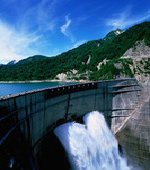 New method for assessing organic pollutant risks in surface waters
New method for assessing organic pollutant risks in surface waters
A new approach to assessing the risk posed by 500 organic chemicals potentially found in the surface waters of river basins across Europe has been developed. It allows pollutants of concern, including emerging substances, to be identified and prioritised by Member States for monitoring and action as required by the Water Framework Directive.
Under the European Union’s Water Framework Directive1 (WFD), Member States are required to ensure that the nation’s surface waters and groundwater are of good status by 2015 and that these waters remain in a healthy condition. In addition to the priority substances identified at EU level, Member States are required to identify and assess the risks of specific chemical pollutants with the potential to cause ecological harm, as listed under Annexe VIII of the WFD.
However, with new or emerging chemicals being added to the already large number of substances being released into the environment, it is not possible for water managers to assess in detail, all pollutants potentially found in a river basin.
The study, conducted under the EU projects MODELKEY2 and OSIRIS3, is the first to develop a classification system that screens organic pollutants and groups them according to the type of assessment and action required. Prioritising substances within the groups then allows water managers to concentrate on monitoring and take action on chemicals considered to be of high priority.
Using water monitoring data taken from four river basins in Europe: the Elbe, Scheldt, Danube and Llobregat, 500 organic pollutants were assessed for risk to the environment. All substances were grouped into one of six categories, according to the quality and quantity of information available, allowing emerging pollutants with minimal hazard (potential harmful effect) data, to be included. For each group, possible management actions were suggested by the researchers.
Within each category, the pollutants were prioritised according to how toxic the substances potentially are (hazard risk) and the amount found in the water environment (assessment of exposure levels). Two indicators were used in the prioritisation process to capture both the extent (number of sites above a certain effect threshold) and local intensity of exposure: exposure levels were based on the maximum concentration, instead of a statistically-derived average concentration, to reflect the potential harm that could be caused to the local environment.
Of the 500 organic compounds assessed, 73 show clear risk of polluting river basin waters. In addition, around 74% of the 44 chemicals that were identified as being potentially high and very high risk were pesticides, a result which does not correspond with the EU-wide priority substances currently listed in the WFD (under Annexe 11). This is potentially alarming, given the strict risk assessments required before pesticides can be approved for market use.
The study also reveals that about one third of the 33 priority substances listed in the WFD do not pose a risk in the waters studied in this research. This suggests that some measures already undertaken as part of the WFD are having a positive impact on the surface waters of Europe’s river basins.
- See: http://ec.europa.eu/environment/water/water-framework/index_en.html
- MODELKEY was supported by the European Commission under the Sixth Framework Programme. See:http://www.modelkey.org
- OSIRIS was supported by the European Commission under the Sixth Framework Programme. See: http://www.osiris.ufz.de
| Contact information |
Email: peter.vonderohe@ufz.de |
|---|---|
| News type | Inbrief |
| File link | n/a |
| Source of information | C von der Ohe, P., Duli, V., Slobodnik, J. et al. (2011) A new risk assessment approach for the prioritization of 500 classical and emerging organic microcontaminants as potential river basin specific pollutants under the European Water Framework Directive. Science of the Total Environment 409: 2064–2077 |
| Keyword(s) | EU-WFD |
| Subject(s) | ANALYSIS AND TESTS , CHARACTERISTICAL PARAMETERS OF WATERS AND SLUDGES , DRINKING WATER , DRINKING WATER AND SANITATION : COMMON PROCESSES OF PURIFICATION AND TREATMENT , HEALTH - HYGIENE - PATHOGENIC MICROORGANISM , HYDRAULICS - HYDROLOGY , MEASUREMENTS AND INSTRUMENTATION , PREVENTION AND NUISANCES POLLUTION , SANITATION -STRICT PURIFICATION PROCESSES , SLUDGES , WATER QUALITY |
| Relation | http://ec.europa.eu/environment/water/water-framework/index_en.html |
| Geographical coverage | n/a |
| News date | 21/09/2011 |
| Working language(s) | ENGLISH |
 you are not logged in
you are not logged in





